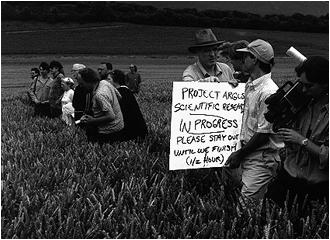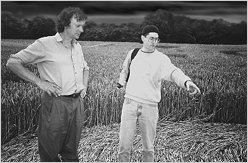 |  | 

Additions
Small, messy circles may be added to your formation at a later date. These are a sign that your formation has been accepted by cerealogists, and
represent an attempt (by these same cerealogists) to pre-empt any future claim on your part. As it is currently fashionable for circle makers not to
make such claims, this practice has become a rather redundant exercise in criminal vandalism. Conversely, and equally redundantly, some additions
have been made by less ambitious (and less talented) circle makers with a mind to claim the entire formation. Bear in mind that the prevailing
atmosphere within the circles network is one of intense paranoia and self-delusion. Our advice is to regard these additions as a compliment.
Scientific analysis
In their attempts to create a universal acceptance of the crop circles' paranormal origins, leading cerealogists often pretend a relationship with
orthodox science. Such phrases as "we are working closely with scientists" or, "we are awaiting the results of analysis" are commonly used in press
releases, for instance, or on the lecture circuit. As well as the possibility that this might fool gullible, provincial journalists who aren't particularly
bothered if they parrot rubbish to their readership, this provides a certain security amongst the rank & file researchers, who, when pressed, will cite
the need for only one circle to be proved to be 'of unknown origin', thereby justifying their pursuance of the phenomenon - an apparently heroic
search for the elusive, hypothetical, white crow. In regard to this, Rupert Sheldrake can be forgiven for his sincere, fleeting, interest in the subject. thereby justifying their pursuance of the phenomenon - an apparently heroic
search for the elusive, hypothetical, white crow. In regard to this, Rupert Sheldrake can be forgiven for his sincere, fleeting, interest in the subject.
Paradoxically, hoaxing - by reminding us that rigourous testing standards should be applied at all times - has always played an important role in the
furtherance of scientific knowledge. As we tend to learn more from negative experience, it creates an atmosphere in which we cannot afford to
assume anything. The rather pompous, well-worn, argument that man-made circles might muddy the important scientific quest for genuine circles
gets weaker, then, as more thought is applied to it. One of the most interesting, and misguided, aspects of cerealogy is the tendency of cerealogists to
hunt and ridicule the 'hoaxer' of circles, whilst simultaneously flooding their own market with bogus scientific reports (and countless other stories),
purporting to be proof of the circles' genuineness. It is worth noting here that as recently as one or two years ago, there was much talk of the 'HUH'
- the Hypothetical Unseen Hoaxer - in the same way as the 'genuine' circle is talked of today; as if, by placing the burden of proof upon followers of
the most reasonable hypothesis, this would add credence to the most unreasonable hypothesis.
Similarly, another 'old chestnut' of cerealogists is the
assertion that, as absolute proof of authorship could only be applied to comparatively few circles, this favours the belief that the majority must be
genuine. Since those halcyon days of the early 90's, and the gradual introduction of a more realistic across-the-board acceptance of human
intervention, this kind of circular thinking has been minimised... limiting itself to a minority of staunch die-hards. It has led, instead, to another
hypothetical, and equally elusive entity; the so-called 'litmus-test' - a method employed to instantaneously determine a 'hoaxed', or 'fake', circle
from 'genuine'. Some will admit that it doesn't exist. Others - more insightful observers perhaps - will have noticed that there are already many
'litmus-tests' currently in use; that it is all a matter of perception and belief ("we must learn to trust ourselves", etc). Dowsing rods are one such form
of instrumentation, which, when finely calibrated and in the right hands can be extremely powerful and convincing... or a whole variety of
magnetometers, spinning compasses, resonating bowls, black boxes with wires and aerials and dials and probes (a Meccano array of electronic
circles detectors), or even portable electron microscopes, it is alleged, for use in the field. The September issue of the Journal for Scientific
Exploration included the CCCS's latest method of determining 'hoaxed' from 'genuine' circles: "Take two cereal heads from the centre of the
formation and another two well outside (100 metres) within the same field. Lay them on the bonnet of your car and think 'AURA' and dowse them.
If there is a difference between the two heads, we are dealing with a genuine formation. (Chairman Michael Green, CCCS Procedures for the 1995
Season - as reported by Dr W C Levengood). All of these methods of detection, and myriad others too ridiculous to mention, provide us with
evidence of something or another. Dowsing rods are one such form
of instrumentation, which, when finely calibrated and in the right hands can be extremely powerful and convincing... or a whole variety of
magnetometers, spinning compasses, resonating bowls, black boxes with wires and aerials and dials and probes (a Meccano array of electronic
circles detectors), or even portable electron microscopes, it is alleged, for use in the field. The September issue of the Journal for Scientific
Exploration included the CCCS's latest method of determining 'hoaxed' from 'genuine' circles: "Take two cereal heads from the centre of the
formation and another two well outside (100 metres) within the same field. Lay them on the bonnet of your car and think 'AURA' and dowse them.
If there is a difference between the two heads, we are dealing with a genuine formation. (Chairman Michael Green, CCCS Procedures for the 1995
Season - as reported by Dr W C Levengood). All of these methods of detection, and myriad others too ridiculous to mention, provide us with
evidence of something or another.
Important note
With such an array of scientific tools, cerealogists welcome any opportunity to use them in the field. Particularly popular are strange substances,
usually found in the centre of the circles - white goo, for instance, or dew-rusted iron filings (meteoric dust)... or anything glowing or luminous -
will quickly attract a flurry of interest. With this in mind, the authors strongly advise that nasty things, such as hospital waste, dangerous
radio-isotopes, blood, or anything remotely caustic be disposed of responsibly and in a correct, legal, manner.
The New Age, rather than being viewed as imminently remote, may already be with us... and us with it. In the Dark Age it was our rationalisation
which brought charges of heresy from institutions creating, and empowered by, fear... whilst also promising salvation from it. Now, in a world
dominated by science and apparent reason, thus marked by a fragmentation of the established church - and then, in turn, the atomisation of those
fragments - it is freedom of belief which seems threatening and heretical. Science implies knowledge, therefore a say in our destiny (doesn't it feel
good to be in control?)... but then, so does mysticism. Perhaps this New Age is a merging of both scientism and mysticism; with each repelling or
embracing the other, like axial magnets {If science is incongruous to mysticism, and the mystical is represented through art, does that elevate bogus
science to an art form?}. In contemporary terms the circles represent a microcosm of this incongruity between the scientific, and the mystical...
chaotic, anti-chaotic - the past, present, and future potential - New Age/Dark Age, all at one with ourselves. Or other such babble.
Photos by Rob Irving: Top, project argus 'scientific' study of circles. Bottom, Rupert Sheldrake with Jim Schnabel.
[ page three of three ]
|  |  |





